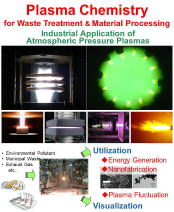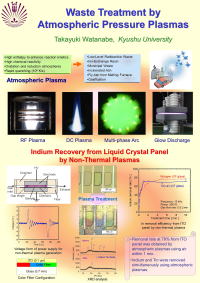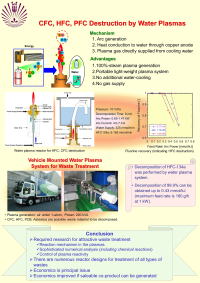|
|
日本語はこちら
Takayuki Watanabe
Professor
Department of Chemical Engineering
Kyushu University
Field of study : Plasma Chemistry, Energy Engineering
Key words : Plasma Processing, Modeling of Plasma Flow, Nanomaterials,
Waste Treatment, Lunar Resource Utilization
http://www.chem-eng.kyushu-u.ac.jp/lab5/index-e.html/
September 29, 2025
|
|
|

ISPC25 (Kyhoto, Japan) May 21-26, 2023 |
NEWS
- May, 2025: Review Paoper "Thermal Plasma System for Innovative Materials Processing" was published on Reviews of Modern Plasma Physics.
- March, 2024: Plasma Chemistry and Plasma Processing, Special Issue, Papers by Plenary and Invited Lecturers at the 25th International Symposium
on Plasma Chemistry (ISPC25), 21-26 May 2023, Kyoto, Japan
- November 13, 2023: Prof. Watanabe has recieved Plasma Innovation Prize, Association of Asia-Pacific Physical Societies, Division of Plasma Physics.
See Review of Modern Plasma Physics.
- September, 2023: Our paper "Effect of Mathane Injection Methods on the Preparation of Silicon Nanoparticles
with Cabon Coating in Induction Thermal Plasma"was selected as Best Paper Award of Journal of Chemical Engieering of Japan.
- May 21-26, 2023: 25th International Symposium on Plasma Chemsitry (ISPC25, Kyoto, Japan), Chair: Prof. Watanabe, Download here
- May 20-21, 2023: IPCS Summer School (Kyoto, Japan), Chair: Prof. Watanabe and Tanaka.
- December, 2021: Prof. Tanaka was promoted to Associate Professor.
- September, 2020: Prof. Tanaka was selected as Trainees of SENTAN-Q (Diversity and Super Global Training Program).
- September 9, 2019: "Kunming University of Science and Technoglogy - Kyushu University Joint Research Center on Plasma Metallurgy Materials" was opened in Kunming, China.
- July 2, 2019: Our paper on The Astrophysical Journal Letters was picked by Physics Today, Making Cosmic Dust in The Lab
- June 11, 2019: Our research about plasma waste treatment was televised on TV program.
- October 12, 2018: Our research about plasma waste treatment was televised on TV program.
- January 1, 2018: The Board of Directors of the International Plasma Chemistry Society.
- September 17, 2017: Our research about plasma waste treatment was televised on TV program.
- April 22, 2016: Our research about plasma waste treatment was televised on TV program.
- November 9, 2014: Our research about plasma waste treatment was televised on TV program. See YouTube
- October 2014: Prof. Watanabe was awarded Plasma Materials Science Awards, Japan Society for Promotion of Sciences, 153rd Committee on Plasma Materials Science.
- March 5, 2012: Our research about plasma waste treatment was televised on Discovery Channel "Rebuilding Japan".
- May 30, 2009: The Prime Minister Observes Advanced Environment-Friendly and Energy-Saving Technology Facilities.
Waste Treatment by Atmospheric Pressure Plasmas can be downloaded from
here.
|
| 1 The subject and aims of research |
|
Thermal plasmas have simply been used as a high temperature source. This indicates that thermal plasmas may have more capabilities in material processing, especially production of high-quality and high-performance materials, if
thermal plasmas are utilized effectively as chemically reactive gases.
Therefore we developed the numerical analysis to investigate non-equilibrium
characteristics in thermal plasmas. These results can be utilized for the
nano-material synthesis as well as waste treatment using thermal plasmas.
|
|
2 Related recent research topics
|
|
Modeling of Reactive Plasma Flows
The induction thermal plasma approach has been applied for many fields, including treatment of harmful waste materials, recovery of useful material from waste, and production of high-quality and high-performance materials, such as synthesis of nanoparticles, deposition of thin films, and plasma spraying. Induction thermal plasmas offer unique advantages including high enthalpy to enhance reaction kinetics, high chemical reactivity, oxidation and reduction atmospheres in accordance with required chemical reactions, and rapid quenching. These advantages increase the advances and demands in plasma chemistry and plasma processing.
However, thermal plasmas have been simply used as high-temperature source,
because argon is typically used as the plasma gas. In some applications
such as reactive plasma spraying, material synthesis, and waste treatment,
thermal plasmas with adding reactive gas are desirable to enhance the chemical
reactivity of the plasma.
Thermal plasmas have been mainly treated as equilibrium conditions even
though sophisticated modeling considering chemical reactions has been required
for industrial applications. In previous works, estimation of thermodynamic
and transport properties was oversimplified, therefore, more sophisticated
models are required. The oversimplified estimation, such as use of equilibrium
properties and use of the first-order approximation of Chapman-Enskog method,
would cause errors in the numerical results.
In order to improve the accuracy of thermodynamic and transport properties,
higher-order approximation of Chapman-Enskog method was applied for estimation
of the transport properties of induction thermal plasmas. The thermal conductivity
and the electrical conductivity by higher-order approximation differ from
those of the first-order approximation especially over 10000 K.
In this study, a non-equilibrium modeling of induction thermal plasmas
was developed without chemical equilibrium assumptions. This formulation
including the finite-rates of dissociation and ionization is presented
using higher-order approximation of Chapman-Enskog method for estimation
of the transport properties.
|

RF plasma temperature distribution for nanoparticle synthesis. |
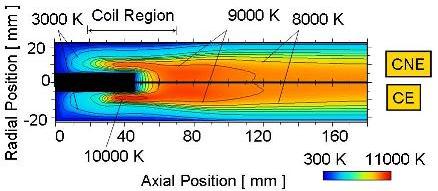
Comparison of temperature distributions obtained from the chemical equilibrium
model (CE) and from the chemical non-equilibrium model (CNE) for argon-oxygen
induction plasmas.
|
|
|
|
|
Development of Innovative In-Flight Glass Melting Technology for Energy Conservation
We developed innovative in-flight glass melting technology under the support of New Energy and Industrial Technology Development Organization (NEDO) project in Japan from 2005 until 2012. The granulated raw material with small diameter is dispersed in thermal plasmas and the powders contact fully with the plasma and burner flame. The high heat-transfer and temperatures of the plasma will melt the raw material quickly. In addition, the decomposed gas of carbonates is removed during the in-flight treatment to reduce the fining time considerably. Compared with the traditional glass production, the total vitrification time is evaluated only 2-3 h in the same productivity as the fuel-fired melter. A multiphase AC arc was developed for the application of glass melting technology. The large volume discharge produced by a stable multiphase AC arc is preferable to melt the granulated glass materials. The discharge behavior and the high-temperature region of the plasma can be controlled by the electrode configurations.
The most important invention is the development of multiphase AC arc. The large volume discharge produced by a stable multiphase AC arc is preferable to melt the granulated glass materials. The discharge behavior and the high temperature region of the plasma can be controlled by the electrode configurations. The spatial characteristics of the arc discharge were examined by image analysis of high-speed camera. Results show arc existence area is related with electrode configuration. This study provides the useful information of efficient particle treatment in the preferred electrode configuration.
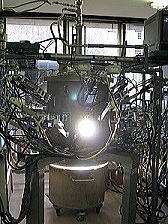 |
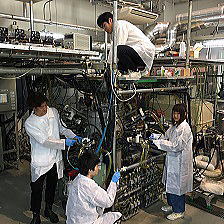

Multiphase AC arc for material processing. |
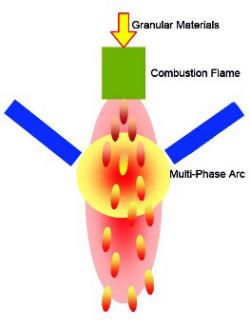
Development of new glass melting technology that can rapidly melt atomized and homogenized granular glass materials.
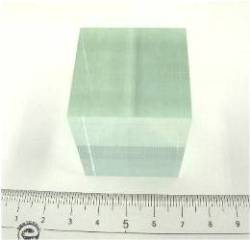
High-quality glass (porosity < 0.01%) were produced from in-flight melted powders.
|
|
|
Generation of Water Plasmas under Atmospheric Pressure
DC 100%-steam plasma characteristics were investigated for the application
of halogenated hydrocarbon decomposition. The developed steam plasma system
is a portable light-weight plasma generation system that does not require
any gas supply. The system has high energy-efficiency since cooling water
is not needed. In addition, a dry process was developed for halogenated
hydrocarbon decomposition and simultaneously adsorbing fluorine and bromine
with solid alkaline reactants.
Water plasma system has been scaled up into a mobile system in a vehicle
with direct-current generator. This innovative in-vehicle plasma has great
advantage to reduce the risk and cost caused by the transportation of harmful
wastes. The developed system has been installed at Helix Co. Ltd., Japan
for the waste oil treatment.
Applications for the destruction of hazardous and waste materials such
as halogenated hydrocarbons by water thermal plasmas were developed. For
halogenated hydrocarbon decomposition, key technologies are the stable
generation of DC water plasmas and the off-gas treatment after the decomposition
of halogenated hydrocarbon. Therefore, DC 100%-steam plasma characteristics
were investigated for the application of halogenated hydrocarbon decomposition.
The developed water plasma system is a portable light-weight plasma generation
system that does not require any gas supply. The system has high energy-efficiency
since cooling water is not needed. In addition, a dry process was developed
for the off-gas treatment of halogenated hydrocarbon decomposition using
solid alkaline reactants.
|
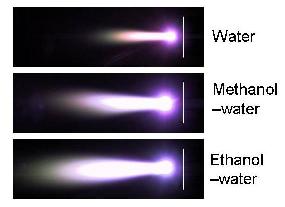
Photographs for water plasma, methanol-water plasma, and ethanol-water
plasma for waste treatments.

In-vehicle water plasma jet. |


Water plasma torch for waste destruction. |
|
|
Preparation of Functional Nanoparticles by Thermal Plasmas
Functional nanoparticles of silicide and boride were prepared by induction
thermal plasmas. Silicide and rare-earth boride are attractive materials
because of their high melting temperature, high electrical conductivity
and low work function. Therefore these nanoparticles would be applied for
electromagnetic shielding, and solar control windows with interaction with
IR and UV light.
For the preparation of silicide, Si powder premixed with metal powder (Mo,
Ti, Co, Fe, Cr, or Mn) was injected into the plasma. For the preparation
of rare-earth boride, premixed powders of rare-earth oxide, B and C were
introduced into the thermal plasma. In the thermal plasma, the injected
powders were evaporated and reacted with boron. After the evaporation and
reaction, the vapor was rapidly cooled after the plasma flame. The nanoparticles
were prepared on condition that the vapor was quickly quenched by the water-cooled
copper coil.
We developed transparent radiation shield by making the shield materials into nanoparticles, and we conducted the collaborative project with Japan Atomic Energy Agency (JAEA).
Recently, We developed nanoparticle synthesis for cathode, anode, and electrolyte of lithium-ion secondary battery. These nanoparticles leads to the development of all solid-state lithium-ion battery improvement with high energy density.
We actively extended the research to the investigation of interplanetary
dust particles contain glass with embedded metals and sulfides (GEMS) grains,
which are considered to be among the building blocks of the solar system.
GEMS grains formed either in the local environment of our protoplanetary
disk considering the nucleation and growth of solids from high-temperature
gas during cooling.
Another purpose is to investigate the condensation mechanism of mixture
vapor of feed powders in thermal plasmas. The characteristics of the prepared
nanoparticles are affected by the vapor pressure ratio of the constituent
materials. Investigation of physical and chemical processes in thermal
plasma processing is indispensable for Nanoparticle synthesis.
|
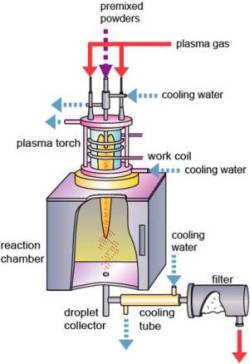 Induction thermal plasma system for nanoparticle synthesis.
Induction thermal plasma system for nanoparticle synthesis. |
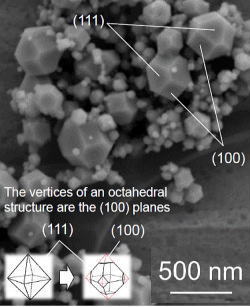 Tetradecahedral Spinel LiMn2O4 were synthesized by RF plasmas for Lithium-ion battery.
Tetradecahedral Spinel LiMn2O4 were synthesized by RF plasmas for Lithium-ion battery. |
|
|
Waste Treatment by Reactive Thermal Plasmas
Attractive thermal plasma processes have been proposed especially for waste
treatment, because engineering advantages such as smaller reactor, lower
capital cost, portability allowing on-site destruction, rapid start-up
and shutdown offer efficient destruction of hazardous and waste materials.
Waste material can be efficiently degraded by thermal plasmas under reducing
or oxidizing conditions. However, thermal plasmas have been mainly used
as a high temperature source. This indicates that thermal plasmas may have
more capability for waste treatment, if thermal plasmas are utilized effectively
as chemically reactive gas.
In this research, application for destruction of hazardous and waste materials
by thermal plasmas is developed. Radioactive waste treatment by thermal
plasmas is an active research field, therefore plasma treatments of low-level
radioactive wastes (LLW) as well as ion-exchange resin are investigated.
Moreover, reactive thermal plasma for halogenated hydrocarbon decomposition
is developed. For halogenated hydrocarbon decomposition, the stable generation
of DC steam plasmas is the important factor for industrial application.
Steam plasmas are suitable for halogenated hydrocarbon decomposition because
hydrogen and oxygen combine with the liberated halogen and carbon atoms
to prevent recombination reactions that result in the reformation of halogenated
hydrocarbons.
|

Thermal plasma jet for waste destruction.
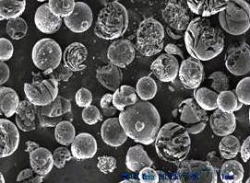
Cobalt doped resins after the plasma treatments. |

Hydrogen generation from waste using thermal plasmas.

Water plasma system for CFC destruction.
|
|
|
Development of Material Processing by Non-Equilibrium Atmospheric Plasmas
Atmospheric pressure plasma has been studied for the application of material
surface cleaning, preparation of surface coating, and modification of polymer
film. In this study, the atmospheric non-thermal plasmas ere applied to
surface cleaning of waste plastic.
The paint attached to waste plastic surface causes low quality of recycled
plastic. The paint removable is difficult by the conventional dry cleaning
process, therefore new cleaning technology for waste-plastic recycle has
been required.
The mechanism of the cleaning with atmospheric plasmas was investigated
from the measurements of optical emission spectroscopy, the atomic concentrations
of plastics surface were measured with electron spectroscopy for chemical
analysis.
Furthermore, a kinetic model is developed to investigate ozone and oxygen
radical production in dry air treated by a non-thermal plasma jet at atmospheric
pressure.
|
 Indium recovery from liquid crystal panel using atmospheric glow discharge.
Indium recovery from liquid crystal panel using atmospheric glow discharge. |
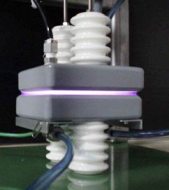 Glow discharge of air under atmospheric pressure.
Glow discharge of air under atmospheric pressure.
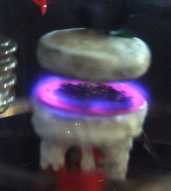 Seed treatment by atmospheric glow discharge.
Seed treatment by atmospheric glow discharge. |
|
|
Lunar Resources Utilization
Ground-engineering work on experimental missions for lunar resource utilization
has been conducted. The goal of the research program is to conceptually
design an experiment system for unmanned water production on the Moon,
and to define essential technological breakthroughs.
As part of the research program, an experimental study on hydrogen reduction
of lunar soil has been performed to design a chemical reactor of the water
production. A fixed-bed reduction reactor and lunar soil simulants were
prepared for our water-production experiments.
Over 20 processes of oxygen production on the moon have been proposed.
Among these processes, oxygen production employing hydrogen reduction is
the most feasible process. In this process, ilmenite contained in lunar
soil is reduced with hydrogen producing water. Oxygen is subsequently produced
by electrolysis. Hydrogen produced in reaction can be recycled.
Understanding the hydrogen reduction mechanism of ilmenite is important
for the mission of utilizing lunar soil. The purpose of this work is to
discuss the possibility and the mechanism of water production.
|
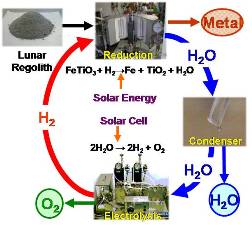 Oxygen production form lunar regolith.
Oxygen production form lunar regolith.
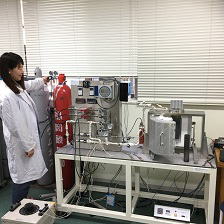
Experiment of water production from lunar soil simulant.
|

Water production system by hydrogen reduction of lunar soil simulant. |
|
List of Publications (Plasma Characteristics, Plasma Generations)
List of Publications (Plasma Materials Processing)
List of Publications (Plasma Waste Treatments, Others)
Books, Patents, Projects, Awards |

